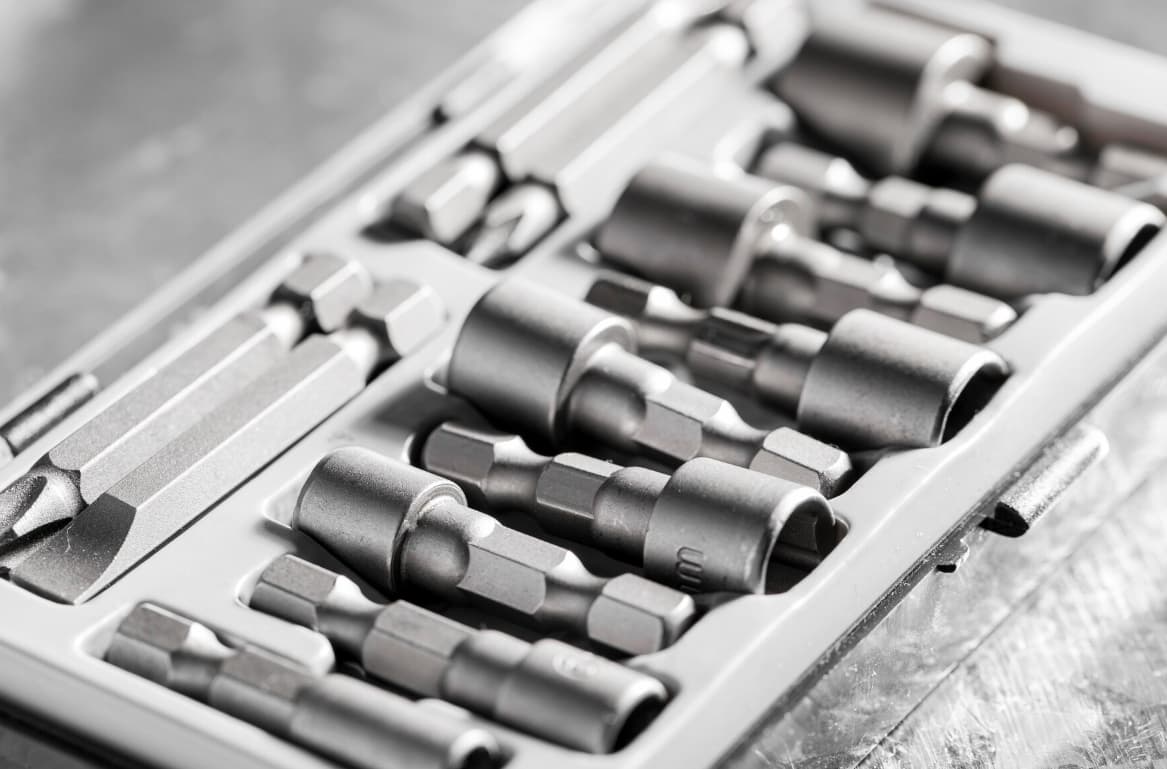Do you know how the metal items you use every day are made? Most objects you interact with, from a can of your favorite soda pop to the hood of your car, started life in the same form – a thin sheet of metal.
Thanks to clever design and a process known as sheet metal fabrication, they slowly take shape and reach their final form.
But it takes more than just placing the metal sheets in a giant mold and giving it shape.
No, metal forming takes time and several specialized tools. It’s those very tools that transform the sheet metal from its raw shape to an object you can use.
And that’s what we’ll focus on here. The many different sheet metal forming tools available and how they work.
Best Sheet Metal Forming Tools

There is a tool for everything – punching, bending, and even stretching metal, and we’ll go over all of them.
It’s always good to know how the things you use every day came to be, and what better way to start learning than discovering the tools used to make them?
Types of Sheet Metal Forming Tools
Would it surprise you to know that the drum in your washing machine and your house’s metal gutters are both made the same way? The method is the same, but the tools that made them are very different.
There isn’t one machine that automatically changes the tools depending on what you want to do. Operators use different equipment for each shaping action.
The most used tools for forming sheet metal include:
- Press Brakes: The bending sheet metal process uses two main parts. The punch is the one that moves, and the die stays in place. You place the sheet metal between these two parts, and the punch comes down, bending it into shape. The machine’s force is carefully calculated so as not to crack or deform the metal but still shape it.
- Roll Forming Machines: These have several rows of rollers that keep turning and can shape long strips of metal. You feed the flat sheet into one end of the machine, and the steel rollers slowly bend it while moving it to the other end of the machine. What comes out is a perfectly formed and straight profile like an H-beam or a metal roof sheet.
- Stamping and Punching Tools: Make a hole or leave a shape in sheet metal using a punching or stamping tool. It works the same way whether it is hand-held or machine-operated. Just place the sheet on a die with an opening in the shape you want to get and press down using the punch. A punching tool will cut out the die indentation, making a hole. On the other hand, a stamping tool will leave an indentation in the metal or give it a specific form.
- Bending Tools: Bending a flat metal sheet at different angles gives it shape and dimension. Bending tools usually result in “V” or “U” shapes, and you can use them on the entire sheet or just the edges for a better-looking finish. For example, using a sheet metal edge forming hammer gives you a cleanly hemmed edge.
- Deep Drawing Dies: This metal shaping process makes deep cylindrical items, which are usually hollow. Think metal cups or cans. Again, it has two main parts: the die cavity, which gives the metal its shape, and the punch, which applies the force that draws the material into the die-cast.
Materials Used in Sheet Metal Forming Tools
Anyone who’s ever worked with any kind of metal knows that your tools must be made of quality stuff.
Otherwise, they will break or even damage your project. Sheet metal forming tools must withstand a lot of metal-on-metal contact and can’t chip or dull easily.
The sheet metal forming tool design must be flawless, and the materials must be very durable and hardy.
That’s why most forming tools for sheet metal are made from:
- Tool steel is a hard, durable material with incredible wear resistance. Most types of tool steel maintain their properties even at high temperatures and seeds. They can make blades that stay sharp when cutting through metal and give clean, precise cuts each time.
- A combination of metal and carbon, carbide creates a long-lasting and incredibly tough material. It’s usually used to make punches, dies, and cutting edges that need to resist a lot of wear.
Coating and Surface Treatments
Another way to improve their performance and make your tools even longer-lasting is to give them a nice coating or surface finish. It beefs up their properties like wear and corrosion resistance. The most common tool treatments are:
- Nitriding – To improve wear resistance and hardness.
- Physical vapor deposition – To reduce friction.
- Chrome plating – To increase corrosion resistance and hardness.
- Fluoride-based coatings – To give higher temperature resistance.
Key Features of High-Quality Sheet Metal Forming Tools
To get high-quality products, manufacturers must use only the best equipment and tools.
Each piece of equipment, big or small, must handle the non-stop pace of large-scale production. You can’t keep stopping in the middle of a production run to change out the blades or get sharper dies each time.
That’s why the tools used for metal fabrication all have:
- Durability and Wear Resistance: Good-quality tools can withstand constant repetitive motion and still stay sharp and chip-free.
- Precision and Accuracy: They make accurate bends and precise cuts with crisp edges.
- Compatibility with Advanced Machining Techniques: This equipment can be used side-by-side with more advanced manufacturing technology, like CAD software and CNC machines.
Applications of Sheet Metal Forming Tools
Using sheet metal fabrication tools isn’t limited to just one sector or industry. If it involves metal, these tools can make almost anything.
From simple home goods to complicated auto body parts, they can cut, bend, or shape into existence.
There is no limit to who can use these tools, but the biggest industries that make components with them include:
- Automotive Industry: Car manufacturers use metal forming tools to make interior and interior components like door panels and hoods. They also make important chassis parts, like the brackets and mounts.
- Aerospace and Defense: This sector only wants high-precision parts and components. Anything less is not acceptable and dangerous. They frequently make aircraft parts and defense components like enclosures and missile fins.
- Consumer Electronics: Chances are the case for your PC or laptop is made using sheet metal tools. They also have a hand in making many external and internal elements for televisions, speakers, and other electronics.
- Construction and Architecture: Most metal accents, like cladding and decorative panels, are made with metal shaping tools. So are important building parts like roofs and ductwork.
Innovations in Forming Tools For Sheet Metal
While some of the tools we mentioned are handheld, most are slowly becoming automated.
Advanced machinery like robotic arms and CNC machines are more and more common during sheet metal fabrication and improve the efficiency of the existing tools.
IoT is also transforming tool management and maintenance.
Thanks to this real-time monitoring, manufacturers can use smart tooling to keep an eye on the condition and performance of their tools.
The gathered data can tell them when it’s time to do repairs or change out a tool that’s worse for wear.
Additive Manufacturing for Tool Prototyping
But what if there isn’t a tool to achieve what you’re trying to do? Well, thanks to 3D technology, you can make it yourself.
You can create a mock-up and build a prototype using software like Solidworks.
Sheet metal forming tools can be anything you want them to be and do anything you want them to.
Challenges in Sheet Metal Forming Tool Development
It’s not easy to create your sheet metal forming tools— at least not as easy as firing up the computer and making a 3D model.
You can achieve consistent, high-quality results through tool wear and tear. Your design must be able to withstand heavy use and not degrade prematurely.
It also has to be made of material compatible with metal fabrication. The tool can’t be too soft or will deform when it comes into contact with the workpiece.
It also can’t be too brittle; otherwise, it will break upon impact. And you can’t choose a material that’s too expensive because making the tool won’t be cost-effective.
Fill Your Toolbox
Now you know what goes into making the things you use every day. Even when they are very different and serve different purposes, there is a common thread connecting them – the tools that made them.
Conclusion:
Sheet metal forming tools take an unassuming flat piece of metal and shape it into a thousand useful forms.
And they are only getting better and more innovative, which means the products they can create will keep improving as well.



